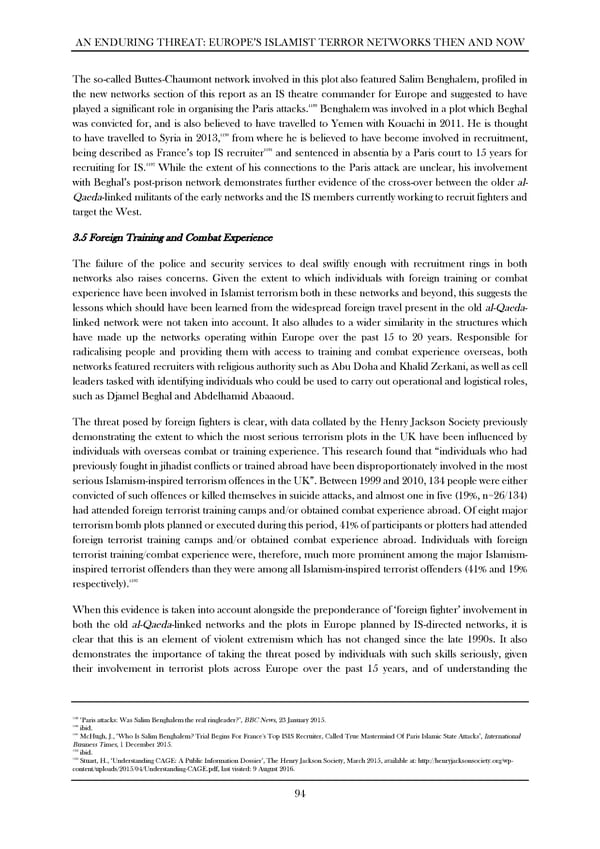AN ENDURING THREAT: EUROPE’S ISLAMIST TERROR NETWORKS THEN AND NOW The so-called Buttes-Chaumont network involved in this plot also featured Salim Benghalem, profiled in the new networks section of this report as an IS theatre commander for Europe and suggested to have 1189 played a significant role in organising the Paris attacks. Benghalem was involved in a plot which Beghal was convicted for, and is also believed to have travelled to Yemen with Kouachi in 2011. He is thought 1190 to have travelled to Syria in 2013, from where he is believed to have become involved in recruitment, 1191 being described as France’s top IS recruiter and sentenced in absentia by a Paris court to 15 years for 1192 recruiting for IS. While the extent of his connections to the Paris attack are unclear, his involvement with Beghal’s post-prison network demonstrates further evidence of the cross-over between the older al- Qaeda-linked militants of the early networks and the IS members currently working to recruit fighters and target the West. 3.5 Foreign Training and Combat Experience The failure of the police and security services to deal swiftly enough with recruitment rings in both networks also raises concerns. Given the extent to which individuals with foreign training or combat experience have been involved in Islamist terrorism both in these networks and beyond, this suggests the lessons which should have been learned from the widespread foreign travel present in the old al-Qaeda- linked network were not taken into account. It also alludes to a wider similarity in the structures which have made up the networks operating within Europe over the past 15 to 20 years. Responsible for radicalising people and providing them with access to training and combat experience overseas, both networks featured recruiters with religious authority such as Abu Doha and Khalid Zerkani, as well as cell leaders tasked with identifying individuals who could be used to carry out operational and logistical roles, such as Djamel Beghal and Abdelhamid Abaaoud. The threat posed by foreign fighters is clear, with data collated by the Henry Jackson Society previously demonstrating the extent to which the most serious terrorism plots in the UK have been influenced by individuals with overseas combat or training experience. This research found that “individuals who had previously fought in jihadist conflicts or trained abroad have been disproportionately involved in the most serious Islamism-inspired terrorism offences in the UK”. Between 1999 and 2010, 134 people were either convicted of such offences or killed themselves in suicide attacks, and almost one in five (19%, n=26/134) had attended foreign terrorist training camps and/or obtained combat experience abroad. Of eight major terrorism bomb plots planned or executed during this period, 41% of participants or plotters had attended foreign terrorist training camps and/or obtained combat experience abroad. Individuals with foreign terrorist training/combat experience were, therefore, much more prominent among the major Islamism- inspired terrorist offenders than they were among all Islamism-inspired terrorist offenders (41% and 19% 1193 respectively). When this evidence is taken into account alongside the preponderance of ‘foreign fighter’ involvement in both the old al-Qaeda-linked networks and the plots in Europe planned by IS-directed networks, it is clear that this is an element of violent extremism which has not changed since the late 1990s. It also demonstrates the importance of taking the threat posed by individuals with such skills seriously, given their involvement in terrorist plots across Europe over the past 15 years, and of understanding the ! ! 1189 ‘Paris attacks: Was Salim Benghalem the real ringleader?’, BBC News, 23 January 2015. 1190 ibid. 1191 McHugh, J., ‘Who Is Salim Benghalem? Trial Begins For France's Top ISIS Recruiter, Called True Mastermind Of Paris Islamic State Attacks’, International Business Times, 1 December 2015. 1192 ibid. 1193 Stuart, H., ‘Understanding CAGE: A Public Information Dossier’, The Henry Jackson Society, March 2015, available at: http://henryjacksonsociety.org/wp- content/uploads/2015/04/Understanding-CAGE.pdf, last visited: 9 August 2016. ! ! 94 !
 An Enduring Threat: Europe’s Islamist Terror Networks Then and Now Page 98 Page 100
An Enduring Threat: Europe’s Islamist Terror Networks Then and Now Page 98 Page 100